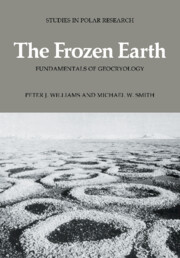Book contents
- Frontmatter
- Contents
- Symbols
- Preface
- Acknowledgements
- 1 PERIGLACIAL CONDITIONS
- 2 MORPHOLOGY OF PERMAFROST AND SEASONALLY FROZEN GROUND
- 3 CLIMATE AND FROZEN GROUND
- 4 THE GROUND THERMAL REGIME
- 5 THE FORMS OF THE GROUND SURFACE 1: SLOPES AND SUBSIDENCES
- 6 THE FORMS OF THE GROUND SURFACE 2: STRUCTURES AND MICROTOPOGRAPHY OF LEVEL GROUND
- 7 THERMODYNAMIC BEHAVIOUR OF FROZEN SOILS
- 8 HYDROLOGY OF FROZEN GROUND
- 9 THE MECHANICS OF FROZEN GROUND
- 10 GEOCRYOLOGY PAST AND FUTURE
- References
- Index
7 - THERMODYNAMIC BEHAVIOUR OF FROZEN SOILS
Published online by Cambridge University Press: 24 October 2009
- Frontmatter
- Contents
- Symbols
- Preface
- Acknowledgements
- 1 PERIGLACIAL CONDITIONS
- 2 MORPHOLOGY OF PERMAFROST AND SEASONALLY FROZEN GROUND
- 3 CLIMATE AND FROZEN GROUND
- 4 THE GROUND THERMAL REGIME
- 5 THE FORMS OF THE GROUND SURFACE 1: SLOPES AND SUBSIDENCES
- 6 THE FORMS OF THE GROUND SURFACE 2: STRUCTURES AND MICROTOPOGRAPHY OF LEVEL GROUND
- 7 THERMODYNAMIC BEHAVIOUR OF FROZEN SOILS
- 8 HYDROLOGY OF FROZEN GROUND
- 9 THE MECHANICS OF FROZEN GROUND
- 10 GEOCRYOLOGY PAST AND FUTURE
- References
- Index
Summary
Soil: a porous system
Those features of ground and terrain that are unique to cold climates arise mainly because of the special conditions which soils and other porous media impose on the water freezing within them. These conditions in soils have only been described in detail in the last three decades, yet are largely what would be expected from a basic knowledge of physical chemistry or thermodynamics. Applying the fundamental sciences to the interpretation of field situations requires careful attention to identifying the terms and concepts used by physicists and chemists with those used by geologists, engineers, soil scientists and others. In the following sections, the physics, chemistry, and thermodynamics of freezing soils are examined further.
The coexistence of ice and water in the soil pores is the most fundamental attribute of frozen soils. Consequently, the study of frozen soils requires consideration of phase change and freezing points.
‘Freezing points’ and latent heat
The freezing point of a substance is generally determined by observation of an abrupt interruption in cooling (Figure 7.1) caused by the release of latent heat of fusion as the liquid turns to solid. The temperature first reaches a minimum, just below 0°C in the case of water, but this involves an unstable supercooling. Freezing occurs following nucleation (the abrupt formation of a stable ice crystal) and the liberated latent heat immediately causes the observed temperature to rise to, or even somewhat above, the equilibrium freezing point.
- Type
- Chapter
- Information
- The Frozen EarthFundamentals of Geocryology, pp. 174 - 201Publisher: Cambridge University PressPrint publication year: 1989



